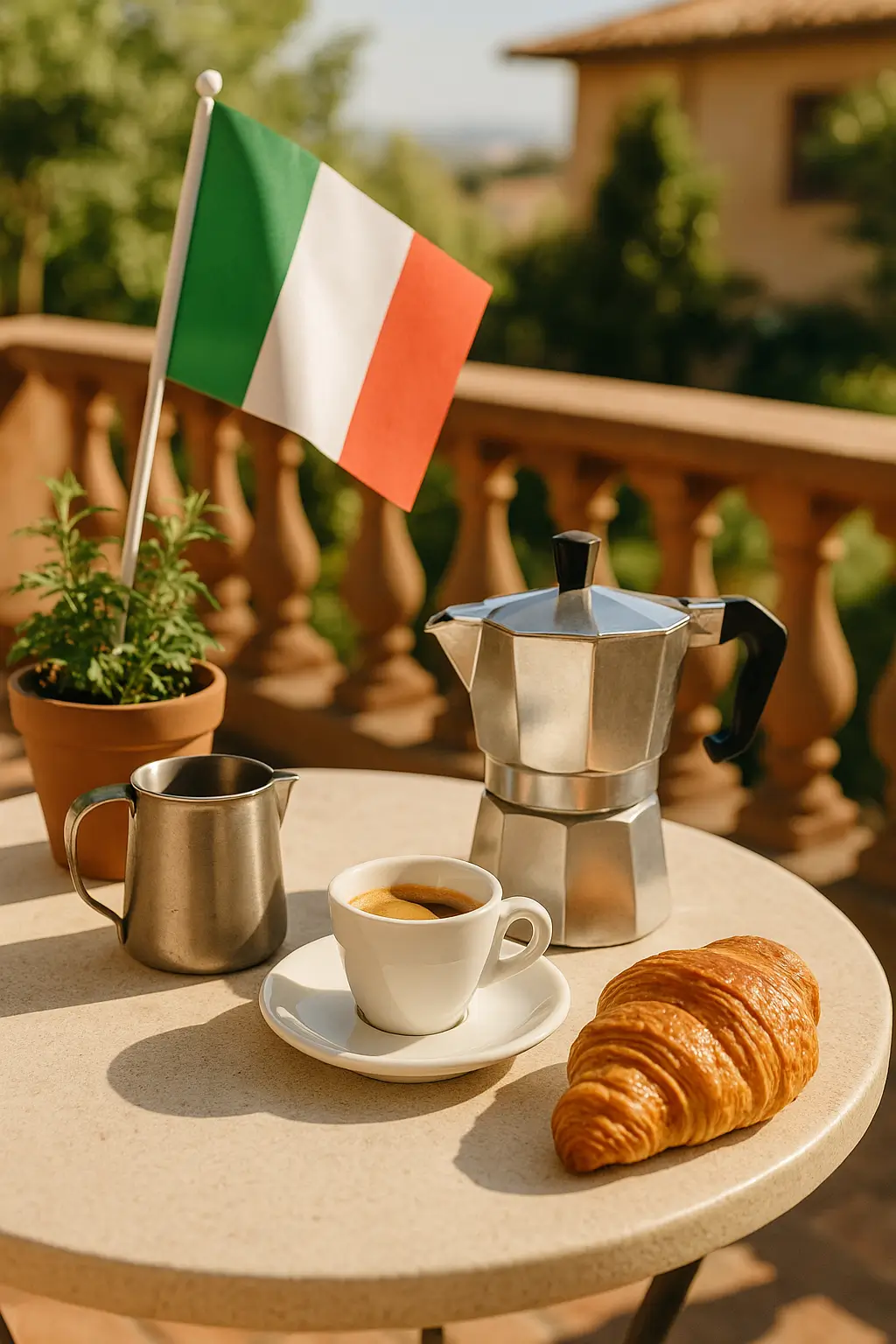Italian coffee is more than a drink. It’s a way of life, deeply woven into Italy’s daily rhythm. You’ll notice its concentrated flavor and rich aroma right away. The heart of it all is the classic espresso. To truly grasp Italian coffee culture, you need to see how they brew it, what drinks they make, and where it all began. Let’s explore what makes Italian coffee special, how people traditionally prepare it, the popular drinks you’ll find, and its big role as a daily social ritual.
- Defining characteristics of authentic Italian coffee
- Traditional Italian coffee preparation methods
- Popular types of Italian coffee beverages and their distinctions
- Profound cultural significance of coffee in Italy
- How Italian coffee differs from global coffee cultures
- Journey through time: Historical origins of Italian coffee
- Key takeaways about Italian coffee
Defining characteristics of authentic Italian coffee
Authentic Italian coffee stands out. It has a robust flavor, a concentrated nature, and a signature aroma. People get this distinct profile from carefully chosen beans and precise brewing. Espresso is the cornerstone of Italian coffee. It’s a small, potent shot, but it gives you a powerful taste. A perfect espresso shows a dense, golden-brown layer on top. This is called crema. It tells you the drink was prepared just right.
The heart of Italian coffee: Espresso and its crema
The espresso truly builds Italian coffee. It shows its strength and character. You see the crema on top of an espresso shot. This means a good extraction. It traps the coffee’s aromatics and leaves a long finish. Baristas get this beautiful crema with high pressure and exact water temperature. Italian roasters often use an Arabica–Robusta blend of coffee beans. This blend helps create the bold flavor and stable crema you expect.
Traditional Italian coffee preparation methods
Traditional Italian coffee relies on two main methods. You use the espresso machine or the common Moka Pot. Each technique makes coffee with different strengths and textures. They suit various tastes. Each method needs specific steps and equipment to get that true Italian flavor.
The art of espresso machine brewing for Italian coffee
Brewing espresso with an espresso machine needs precision. Baristas start with very finely ground coffee. This lets the water interact fully. The machine then pushes hot water through the grounds. It hits a precise temperature, usually 88–93°C (190–200°F). High pressure, about 9 bars, drives this process. A single shot takes 20–30 seconds to extract. Tamping is a key step. You press the coffee beans into the portafilter with about 44 pounds of force. This ensures even water flow and stops channeling.
The stovetop essential: The Moka Pot for Italian coffee
The Moka Pot is a favorite stovetop tool. It brings robust Italian coffee flavor into homes everywhere. This device has three chambers. It brews coffee using steam pressure. Water in the bottom chamber heats up. It rises through the coffee grounds in the middle. Brewed coffee collects in the top chamber. The coffee you get is strong, rich, and robust. Always use low heat to avoid burning. Gently stir the coffee once it brews. This makes sure it has an even consistency.
Popular types of Italian coffee beverages and their distinctions
Italy has many different coffee drinks. Each one uses a unique mix of espresso, milk, and foam. These preparations fit different tastes and times of day. This shows Italy’s careful way of enjoying coffee. You’ll find everything from pure, intense shots to creamy, milky drinks. There’s something for everyone.
Caffè (Espresso) and its core variations in Italian coffee
Caffè is the standard espresso. It’s the classic Italian coffee experience and the base for many variations. If you order “un caffè” in Italy, you always get a single shot of strong, concentrated espresso in a small cup. A “doppio” gives you a double shot, so it’s twice as intense. For even more concentration, a “Caffè Ristretto” uses less water. This makes a smaller, very potent shot. On the other hand, a “Caffè Lungo” has more water. It creates a larger, lighter-flavored espresso. Then there’s “Caffè Americano.” This dilutes espresso with hot water. It looks like filter coffee, but it starts with an espresso base.
Beloved milk-based Italian coffees
Italy enjoys many milk-based coffee drinks. Each has unique traits and traditional rules for drinking it.
- Cappuccino: This classic drink has equal parts espresso, steamed milk, and milk foam. Italians typically drink Cappuccino only in the morning, often with a pastry like a cornetto. You can find “Cappuccino Chiaro” (more milk, less foam), “Cappuccino Secco” (mostly frothy milk foam), and “Cappuccino Scuro” (more coffee, less milk),
- Caffè Macchiato: This means “stained coffee.” It is an espresso with a small bit of steamed or foamed milk. It’s stronger than a Cappuccino since it has less milk. A “macchiatone” is a bit bigger, between a Caffè Macchiato and a Cappuccino,
- Caffè Latte: This drink has more milk than a Cappuccino. It mixes espresso with warm milk and just a touch of foam. It offers a milder, milkier taste,
- Latte Macchiato: This drink is mostly steamed milk. You “stain” it with an espresso shot. They pour it to create layers of milk and coffee.
| Drink | Description | When to drink |
|---|---|---|
| Espresso (Caffè) | Small, concentrated shot of pure coffee | Any time, often standing |
| Doppio | Double espresso shot | Any time |
| Caffè Ristretto | Very short, potent espresso | Any time, for a quick jolt |
| Caffè Lungo | Longer, lighter espresso (more water) | Any time, milder taste |
| Caffè Americano | Espresso diluted with hot water | Any time, resembles filter coffee |
| Cappuccino | Equal parts espresso, steamed milk, foam | Mornings only (before 11 a.m.) |
| Caffè Macchiato | Espresso “stained” with a bit of milk | Afternoon, lighter than cappuccino |
| Caffè Latte | More milk than cappuccino, light foam | Any time, milder, milkier |
| Latte Macchiato | Steamed milk “stained” with espresso | Any time, layered drink |
Profound cultural significance of coffee in Italy
Italian coffee culture goes beyond just drinking coffee. It’s built into daily life. It acts as a social ritual. Coffee brings people together. It creates connection, conversation, and community. The quick, precise act of drinking coffee breaks up the Italian day. It offers moments of pause and enjoyment. It’s an art form and a symbol of Italy itself.
Coffee as a daily social ritual in Italian coffee culture
Coffee is a central social ritual in Italian culture. It helps people connect and build community. Italians usually drink espresso quickly. They stand at a “Coffee Bar” or coffee counter. This spot becomes a lively social hub. The morning espresso ritual often comes with a sweet pastry, like a cornetto. It signals the start of the day. The “Caffè Sospeso” (suspended coffee) tradition shows generosity. A customer pays for an extra coffee for someone who needs it. This practice shows coffee’s role in social kindness. It builds on the communal spirit. It also highlights “Caffè al Banco” (coffee at the counter) as a quick, social interaction.
Etiquette and consumption customs for Italian coffee
Italian coffee culture follows unwritten rules for enjoying coffee all day. For example, people avoid Cappuccino after 11 a.m. Italians see it as a breakfast drink because of its milk. A Caffè Macchiato, with its small milk splash, is often better in the afternoon. It’s a lighter choice, not as filling. These customs show respect for tradition. They also show a fine understanding of digestion and social graces.
How Italian coffee differs from global coffee cultures
Italian coffee sets itself apart from other traditions in several key ways:
- Unique brewing methods,
- Specific bean preferences,
- Darker roast profile,
- Deep cultural integration.
These differences make a coffee experience that is purely Italian. It focuses on intensity, quickness, and social ties. The strong emphasis on espresso-based drinks also makes it unique compared to other places.
Brewing methods compared for Italian coffee
Italian espresso and Moka Pot brewing methods differ greatly from common techniques in other coffee cultures. The espresso machine uses high pressure to make a concentrated shot. This is unlike gravity-fed drip coffee makers or immersion French presses you see elsewhere. The Moka Pot uses steam pressure for a robust stovetop brew. Pour-over or instant coffee don’t have this pressure element. This focus on pressure extraction gives Italian coffee its intense, full-bodied taste.
Bean selection and roast profile for Italian coffee
Italian coffee’s character comes from two things. They prefer darker roasted coffee beans. They also often include Robusta beans. Many global coffee cultures like lighter roasts. These show off subtle origin flavors. Italy, however, uses a darker roast profile. This makes the coffee bold and gives it a richer, more consistent taste. Adding Robusta beans to an Arabica–Robusta blend creates a unique crema. It also gives higher caffeine and a stronger body. This differs from pure Arabica coffees common elsewhere. This specific bean and roast choice guarantees the strong, intense flavor Italians love.
Cultural practices and consumption styles of Italian coffee
Italian coffee’s cultural practices and consumption styles differ greatly from other cultures. Other places often have leisurely, large servings. Italians, though, enjoy quick, at-the-bar espresso. They often have several small shots throughout the day. These are brief, standing rituals at a coffee bar. This is very different from drinking large, often sit-down American drip coffee or other filter brews. Italian coffeehouses focus on authentic, consistent preparation. They make sure each cup follows established traditions. This focus on speed and ritual makes coffee a core part of daily life.
Journey through time: Historical origins of Italian coffee
The history of Italian coffee goes back centuries. It started as an exotic import. Now it’s a national symbol. Italy played a big role in spreading coffee culture across Europe. Trade, curiosity, and new technology drove this. This history shows how coffee became deeply rooted in Italian society. It shaped social customs and daily routines.
How Italian coffee was introduced via Venice
Coffee came to Italy in the 16th century. It arrived mainly through Venice, a busy trade center. Venetian merchants and travelers traded with the Ottoman Empire. They first brought coffee to the peninsula. Prospero Alpini, a Venetian botanist, was key in this. He imported coffee plants from Egypt in 1580. People were unsure at first. But coffee gained acceptance after Pope Clement VIII reportedly tasted it. He liked it and gave it his blessing around the early 17th century. This opened the way for coffee in wider Italian society.
The rise of Italian coffeehouses in coffee history Italy
Italian coffeehouses rose up and changed coffee. It became a lively social and intellectual activity. By the 17th and 18th centuries, these places became important centers. Intellectuals, artists, and social groups met there. They shared ideas. People gathered to discuss ideas, do business, and enjoy relaxed talks over coffee. The early 20th century brought a big technological jump. The first espresso machines got patented. This changed coffee preparation. It cemented Italy’s place at the forefront of modern coffee culture.
Key takeaways about Italian coffee
Italian coffee is more than just a drink. It combines rich history, careful preparation, and deep cultural traditions. You’ll notice its strong, concentrated espresso flavor. You’ll also see the useful stovetop Moka Pot. And you’ll love the wide range of milk-based drinks like cappuccino and caffè macchiato. This unique way of doing coffee made Italian coffee culture a daily ritual. It focuses on quick sips at the coffee bar and strong social ties. Coffee came to Italy through Venice in the 16th century. Then came the espresso machine. Italian coffee always changed, but it kept its core identity. It’s a cornerstone of the Italian lifestyle. You can experience the authentic taste of Italian coffee. Try brewing it at home, or visit an Italian coffee bar.









